Contents
Toggle
Meet David De’ Ath, founder, editor, and writer at Wonderful World English. With his extensive background as an English teacher, David provides valuable insights and practical tips on ESL for students and teachers alike.
English as a Second Language (ESL) is an educational discipline that focuses on teaching English to individuals whose primary language is not English.
Many methods, materials, and tools are employed to ensure students can effectively learn to communicate in English.
ESL programs are essential for integrating students into English-speaking environments, facilitating both personal and professional growth.
Teaching English can take various forms, from classroom-based learning to online courses and resources.
Engaging with ESL helps learners develop their language skills and enriches their understanding of different cultures and societies.
The landscape of ESL education continuously evolves, incorporating new technologies and methodologies to enhance the learning experience.
Key Takeaways
- ESL is dedicated to teaching English to non-native speakers.
- Effective communication in English is the primary goal of ESL education.
- A variety of teaching approaches and resources are used in ESL programs.
Getting Started with ESL
Understanding the framework and utilizing the right resources can establish a solid foundation for learning English as a second language.
ESL is pivotal for non-native speakers aiming to achieve proficiency in English, whether for personal growth, academic success, or professional advancement.
Understanding ESL and Its Importance
ESL is an educational approach that facilitates English language learning for non-native speakers.
It is crucial because it bridges communication gaps and opens doors to a plethora of opportunities in global contexts.
Materials tailored for ESL learners are developed to cater to different proficiency levels, with a special emphasis on beginners to ensure a gradual and thorough comprehension of the English language.
- Importance for learners:
- Improves communication: Proficiency in English can help learners interact effectively in diverse settings.
- Enhances opportunities: A solid command of English can lead to better educational and employment prospects.
Resources for Teachers & Students
To navigate through the initial stages of ESL, teachers and students need access to high-quality resources that provide structured learning materials.
For Teachers:
- Engaging lesson plans
- Audiovisual aids
- Interactive activities
For Students:
- Comprehensive textbooks.
- Online platforms like LearnEnglish offer extensive free materials.
- Conversation prompts found on websites such as ESL Conversation Starters and Questions.
English learners at the beginner level should be exposed to vocabulary and sentence structure through repetitive and interactive formats that enhance retention and encourage practical application.

Developing English Skills
Developing English skills is a multifaceted process that involves building a strong foundation in grammar, advancing reading and writing proficiency, and actively practicing speaking and listening.
Achieving fluency in English requires dedicated efforts across these critical areas.
Building Strong Grammar Foundations
He or she must understand the rules and structures of English to form correct sentences and communicate effectively.
Utilizing worksheets and grammar exercises can reinforce this foundation.
It is essential to focus on the various parts of speech and their correct usage, along with tense consistency.
Grammar guides and online resources provide structured practice, essential for mastering the complexities of English grammar.
Advancing Reading & Writing Proficiency
To develop their reading and writing skills, learners should immerse themselves in a wide range of English texts.
This includes fiction, non-fiction, newspapers, and online articles.
Varied reading materials enhance vocabulary and comprehension while writing tasks such as essays, journal entries, and reports, improving their ability to express ideas in writing.
For writing skills advancement, feedback is crucial. It ensures that learners understand their errors and learn how to correct them.
Practicing Speaking & Listening
One cannot stress enough the importance of practicing speaking and listening in real-world situations.
Engaging in conversation with native speakers or fellow learners helps one to apply grammar and vocabulary knowledge to speaking.
It’s beneficial to include listening materials, like podcasts or educational videos, which expose learners to different accents and speaking speeds.
Recording oneself and comparing it with native speakers can pinpoint areas for improvement in pronunciation and fluency.

Specialized ESL Topics
Specific topics in an ESL curriculum are designed to meet the unique goals and professional needs of learners.
These specialized topics extend beyond general language skills, focusing on areas that prepare students for real-world applications.
Business English and Career Prep
The Business English subsection caters to professionals and students aiming to refine their language proficiency in a corporate context.
Lesson plans typically include vocabulary specific to various industries, exercises in formal communication, and practice speaking in business scenarios.
- Vocabulary: Emphasizes industry-specific terms
- Exercises: Role-play, email writing, negotiations
- Video Lessons: Offer real-world context and examples
Prep Time for instructors involves tailoring materials to the students’ career ambitions and often incorporating case studies or current economic discussions to enhance relevance.
Exam Preparation & Practice
Learners seeking to validate their English proficiency through standardized tests benefit from targeted exam preparation.
This includes understanding test formats, mastering question types, and extensive practice speaking and listening segments.
- Exercises: Sample test questions, timed drills
- Lesson Plans: Aligned with exam content, offering sequential learning
Video Lessons are particularly beneficial for acclimating students to the pacing and auditory component of exams.
Strategically designed practice materials and mock exams equip students with the confidence and skills to succeed.
Are you considering a new adventure teaching English abroad but are unsure if this is the right move for you?
If so, check out the insightful guide below!
Related: Should I Teach English Abroad: Top Reasons to Take the Leap

Resources and Materials
Educators require a diverse set of tools to teach ESL effectively.
These resources not only help in outlining the curriculum but also engage students in the learning process.
Materials such as lesson plans and handouts are vital for structured learning, while flashcards and games offer reinforcement in a more dynamic context.
Lesson Plans and Handouts
A well-structured lesson plan ensures that teachers cover all necessary language skills systematically.
For example, ESL Friend provides free resources that are instrumental in designing lessons for different proficiency levels.
Handouts supplement these plans by giving students tangible materials to review and practice.
At ISL Collective, teachers can find an extensive array of English ESL handouts in pdf format, catering to various aspects of language learning such as grammar and vocabulary.
- Resources for Teachers:
- Free ESL resources
- Printable worksheets
- Detailed lesson plans
Extra Practice with Flashcards and Games
Flashcards serve as a versatile tool for vocabulary reinforcement.
They assist learners in memorizing and recalling words effectively.
They can be easily created or sourced from online platforms that provide ready-to-use materials.
On the other hand, games introduce a fun element into the learning process.
They encourage students to apply their language skills in playful scenarios.
ESL Pals offers both printable flashcards and interactive games suitable for different age groups and skill levels.
- Learning Materials for Students:
- Flashcards for vocabulary building
- Interactive ESL games
- Online quizzes and exercises
By incorporating a variety of teaching resources and learning materials, educators can create an engaging and comprehensive ESL program.
This caters to the needs of diverse learners.
For our complete guide on the BEST games to learn English, perfect for any home or classroom, check out the link below!
Related: Best Games to Learn English: Ultimate Guide

Conclusion
The dynamic field of ESL education continues to evolve, offering varied and effective teaching strategies that cater to the needs of non-native English speakers.
By leveraging a range of methods, from traditional classroom settings to innovative online platforms, ESL educators can provide comprehensive language education that enhances students’ linguistic abilities and broadens their cultural understanding.
The incorporation of modern technologies and teaching materials enriches the learning experience, making English language acquisition more accessible, engaging, and effective for learners worldwide.
As ESL education progresses, it remains crucial for educators to adapt to new teaching tools and methods to keep up with the educational demands of today’s learners.
The ultimate goal of ESL teaching is to equip students with the necessary skills to communicate effectively in English, thus opening up more opportunities for personal and professional growth in a globally connected world.
We hope you find value in this information; you can contact us if you require any support.
Have a wonderful day!
Image Attribution: All images licensed via canva.com





